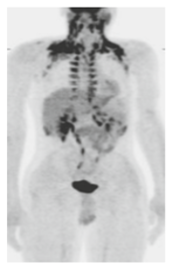Saudi Nuclear Medicine Club " Quiz #2 " @saudi_nmc

" Quiz #2 " @saudi_nmc
Time: 8mins
10 Questions [ 10 multiple-choice ]
Number of Attempts Allowed: 5
Good Luck :)
- 1.
1. Truncation artifacts in PET/CT imaging are produced by
- A.
Contrast medium
- B.
Difference in size of FOV between PET and the CT
- C.
Patient may drink water but should not eat.
- D.
Difference in scanning time between PET and the CT
Correct Answer
B. Difference in size of FOV between PET and the CTExplanation
Discrepancy between fields of view (FOVs) in a PET/CT scanner—70 cm causes a truncation artifact when imaging extends beyond the CT FOV-50 cm; as a result no attenuation correction values for the truncated anatomy are being applied.Rate this question:
-
- 2.
2. A PET system capacity to distinguish between two points after image reconstruction is called :-
- A.
Contrast
- B.
Resolution
- C.
Attenuation
- D.
Emission
Correct Answer
B. ResolutionExplanation
PET system resolution, according to NEMA guidelines, is assessed by imaging a point source in the air and reconstructing the images with no smoothing or transformation of images. The resolution of the system is affected by the annihilation ambiguities, the detector ring diameter and the size of the scintillation crystalRate this question:
-
- 3.
3. All of the following positron emission tomography myocardial perfusion tracers are cyclotron produced EXCEPT:
- A.
Water O-15
- B.
Rubidium Rb-82
- C.
Acetate C-11
- D.
Ammonia N-13
Correct Answer
B. Rubidium Rb-82Explanation
Rb-82 is produced from a strontium-82 (Sr-82)/Rb-82 generator, which can be eluted every 10 min. The half-life (T1/2) of Sr-82 is 25.5 days, which results in a generator life of 4–8 weeksRate this question:
-
- 4.
4. In general, the best radiopharmaceutical to use for a suspected abdominal abscess is
- A.
67Ga citrate
- B.
111In-labeled leukocytes
- C.
111In satumomab pendetide
- D.
111In octreotide
Correct Answer
B. 111In-labeled leukocytesExplanation
It is best to use a radiopharmaceutical with less gastrointestinal excretion; therefore, 67Ga should be excluded. Octreotide is used for tumors with somatostatin receptors, and satumomab pendetide is a monoclonal antibody used mainly for colorectal and ovarian cancers, so these are not helpful. 111In-labeled leukocytes would be useful; GI activity will not be present when disease is absent.Rate this question:
-
- 5.
5. In a patient with renal artery stenosis
- A.
A post captopril study will show increased GFR
- B.
A post captopril study will show decreased GFR
- C.
A post captopril study will show GFR to be unchanged
Correct Answer
B. A post captopril study will show decreased GFRExplanation
Patients who have renal artery stenosis, when given an ACE (angiotensin-converting enzyme) inhibitor, will show a decrease in GFR. Therefore, captopril renography is an effective examination to determine whether renal artery stenosis is the cause of hypertensionRate this question:
-
- 6.
6. What imaging agent can be used to image the skeleton as well as myocardial infarction
- A.
99mTc MDP
- B.
99mTc HDP
- C.
99mTc PYP
- D.
201TL chloride
Correct Answer
C. 99mTc PYPExplanation
pyrophosphate can be used for bone scintigraphy, myocardial infarction, and blood pool imagingRate this question:
-
- 7.
7. the dose calibrator quality control procedure performed with different sealed radionuclides is called:
- A.
Geometry
- B.
Accuracy
- C.
Linearity
- D.
Constancy
Correct Answer
B. AccuracyExplanation
A ccuracy testing is performed at installation and then annually, with at least two different sealed sources, e.g., Co-57, Cs-137, and Ba-133Rate this question:
-
- 8.
8. The enormous decrease in photons detection efficiency by SPECT, when compared to that of PET, is caused by:
- A.
Shorter imaging time
- B.
Lower injected dose
- C.
Use of collimator
- D.
Use of shielding
Correct Answer
C. Use of collimatorExplanation
image resolution is inferior to that of PET because emission of single photon requires the use of a collimator to acquire image dataRate this question:
-
- 9.
9. What should have been done to avoid the artifact illustrated in Fig.1 ?
- A.
Administer insulin
- B.
Administer glucose
- C.
Keeping the patient warm during the uptake phase after the FDG injection
- D.
Keeping the patient cool during the uptake phase after the FDG injection
Correct Answer
C. Keeping the patient warm during the uptake phase after the FDG injectionExplanation
Keeping the patient warm during the uptake phase after the FDG injection The MIP image demonstrates intense FDG uptake in brown fat, and excessive metabolism in the neck and paraspinal area. Keeping the patient warm and comfortable prior to injection can reduce such activity.Rate this question:
-
- 10.
10. When monitoring response to treatment with PET-FDG imaging is essential to obtain:
- A.
Baseline PET-FDG scan
- B.
Interim PET-FDG scan
- C.
PET-FDG scan on the last day of therapy
- D.
PET-FDG scan two days after therapy
Correct Answer
A. Baseline PET-FDG scanExplanation
Baseline PET-FDG scan To monitor response to therapy and to reduce the risk of false-negative and false-positive readings, it is recommended that a baseline scan be available for assessmentRate this question:
-
Quiz Review Timeline +
Our quizzes are rigorously reviewed, monitored and continuously updated by our expert board to maintain accuracy, relevance, and timeliness.
-
Current Version
-
Mar 21, 2023Quiz Edited by
ProProfs Editorial Team -
May 07, 2020Quiz Created by
Zeem



